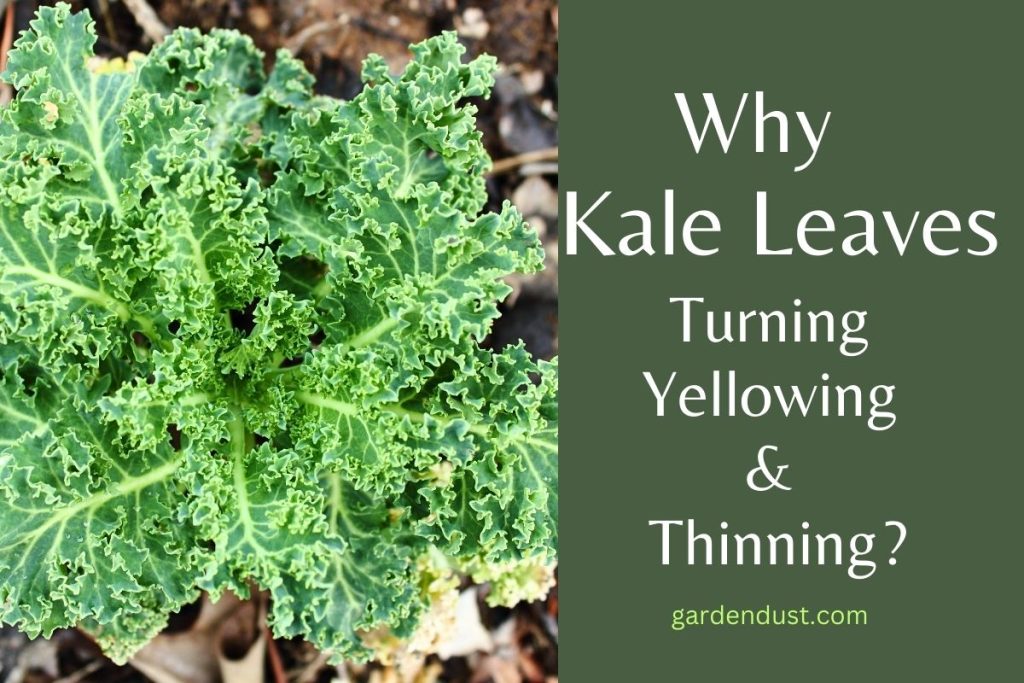Kale, a nutritional powerhouse and a staple in many health-conscious diets, is renowned for its robustness and rich green hues. However, when kale leaves start turning yellow and thinning, it raises concerns among growers and enthusiasts. In this detailed exploration, we unravel the mysteries behind these symptoms, delving into the various 6 Reasons -Why Kale Leaves turning Yellowing and Thinning. Understanding these issues is crucial for maintaining a thriving kale crop and ensuring that this superfood continues to grace our plates with its full nutritional potential. Let’s start….
Why Kale Leaves turning Yellowing and Thinning
1. Nutrient Deficiency
One of the primary reasons for kale leaves turning yellow and thinning is nutrient deficiency. Kale, like all plants, requires a balanced supply of essential nutrients for optimal growth. Nitrogen, in particular, plays a vital role in leaf development. A deficiency in nitrogen can result in yellowing leaves, known as chlorosis, and overall thinning of the foliage. To address this issue, growers should consider incorporating a well-balanced fertilizer with adequate nitrogen content into their kale cultivation routine. Additionally, regular soil testing can help identify deficiencies in other essential nutrients, such as potassium and iron, ensuring a comprehensive approach to nutrient management.
2. Improper Soil Conditions
The health of kale plants is closely tied to the conditions of the soil in which they grow. Compacted or poorly-draining soil can lead to waterlogged roots, reducing the plant’s ability to uptake nutrients and causing stress. This stress often manifests as yellowing and thinning of leaves. Amending the soil with organic matter, such as well-rotted compost, improves soil structure and drainage. Adequate spacing between plants also enhances air circulation around the leaves, reducing the risk of fungal diseases that may contribute to yellowing.
READ ALSO:-HOW TO GROW AND CARE FOR NASTURTIUMS
3. Overwatering or Underwatering
Watering practices play a pivotal role in the health of kale plants. Both overwatering and underwatering can lead to stress and result in yellow, thinning leaves. Overwatering can lead to waterlogged soil, depriving the roots of oxygen and hindering nutrient absorption. On the other hand, underwatering can lead to drought stress, causing leaves to wilt, turn yellow, and eventually thin out. Implementing a consistent watering schedule, ensuring proper drainage, and using mulch to retain soil moisture can help strike the right balance for kale plants.
4. Pests and Diseases
Pests and diseases can also contribute to the yellowing and thinning of kale leaves. Aphids, spider mites, and cabbage loopers are common pests that can sap the nutrients from kale plants, causing leaves to yellow and thin. Regular inspection and the introduction of beneficial insects, such as ladybugs, can help manage pest populations. Fungal diseases, such as downy mildew and powdery mildew, can affect kale leaves, leading to yellowing and thinning. Fungicidal treatments and proper spacing to improve air circulation are effective strategies for disease management.
5. Environmental Stress
Environmental stressors, such as extreme temperatures or sudden fluctuations, can take a toll on kale plants. High temperatures, especially during the summer months, can cause kale leaves to wilt, turn yellow, and become thin. In contrast, exposure to cold temperatures can lead to chilling injury, resulting in similar symptoms. Providing shade during excessively hot periods and covering plants during unexpected frost events can help mitigate environmental stress. Additionally, planting kale during the appropriate season for your region and choosing heat-tolerant varieties can enhance the plant’s resilience to environmental fluctuations.
6. Age of the Plant
The natural aging process of kale plants can also contribute to yellowing and thinning of leaves. As kale matures, the older leaves at the bottom of the plant may naturally turn yellow and thin out. This is a normal part of the plant’s growth cycle, and it allows the plant to redirect energy to newer leaves at the top. Regular pruning of yellowed and senescent leaves not only improves the overall appearance of the plant but also encourages the production of fresh, healthy foliage. It’s essential for growers to distinguish between normal aging and abnormal symptoms caused by external factors to determine the appropriate course of action.
In the intricate dance between kale and its environment, yellowing and thinning leaves serve as signals, urging growers to decipher the underlying causes. Whether it’s a nutrient deficiency, soil-related issues, pests, diseases, environmental stress, or the natural aging process, understanding these factors is paramount for effective kale cultivation. By adopting a holistic approach that addresses soil health, watering practices, pest management, and environmental conditions, growers can ensure that their kale crop thrives, delivering vibrant and nutrient-rich leaves to the table. As we navigate the complexities of kale cultivation, let these insights guide us in maintaining the verdant allure and nutritional potency of this leafy green superfood. Happy Gardening….







